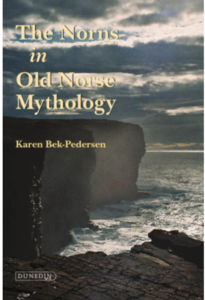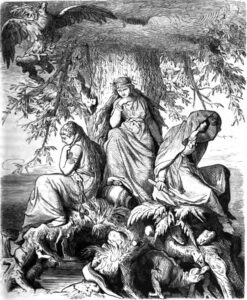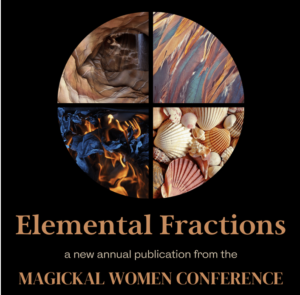The Norns in Old Norse Mythology by Karen Bek-Pedersen
Dunedin Academic Press Ltd, 2011
224 pages, including index and extensive bibliography
With impeccable timing, my copy of this book (ordered directly from the publisher) arrived a few weeks prior to the deadline for the Jotnar-themed issue of Idunna, the magazine of The Troth, where this review first appeared.

The book is based on the author’s doctoral thesis. While expanded for a broader audience, it is still a chewy work, giving the reader much to consider, without being unreadable in its thoroughness. All references to other works are clearly and understandably noted, and the endnotes to each chapter add useful information without bogging down the main text.
She acknowledges what all of us who engage in research keep in mind as we do our work:
“It should not be imagined that Old Norse mythology, world view and traditions were ever static; culture is a continuous process, not a finished product.”
Page 3
Bek-Pedersen begins with a discussion of the difficulty of defining the Norns, in relation to, and distinct from, other powerful female figures—disir, valkyrur, fylgjur, and volur. While there is overlap between the Norns and each of the other figures, she finds sufficient material in the sources to establish the Norns as a unique type. This in particular stood out as I was reading:
“Nornir rarely appear in person but it is common for volur to do so, and it seems fair to say that nornir are generally conceived of as distant, intangible beings who go about their tasks somewhere beyond human reach while volur, where these are described as physically present in human society, represent a more comprehensible version of similar otherworldly knowledge. Volur nevertheless always retain some otherworldly quality. In this way, volur and nornir may actually represent similar notions, only in different formats or on different levels.”
Page 60 – Page 61
The volva as a messenger from the Norns—does this sound like Oracular Seidhr, or what?
She then moves to a discussion of the names as we currently know them—Urd, Verdandi, and Skuld—and their domains of past, present, and future. Surprisingly, there is not a great deal of support in the the Lore for this particular set of names, nor for the past/present/future attributions, despite these being so common in modern practice. Her conclusion is that, while each region had its own myths and aspects for the spirits and deities, the similarity of these associations seems more like a later imposition, bringing in the qualities and associations with the Fates by those educated in classical Greek or Roman myths. That may be, but the names and temporal associations work quite well, so I’m going to continue with it in my practice.
The fourth chapter contains a discussion of the Norns and their associations with textile work. The chapter opens:
“The fact is that textile and textile work are in many ways good metaphors for how the concept of fate operates. But the fact is also that there are no clear-cut and unequivocal representations of the nornir engaged in spinning or weaving to be found anywhere in Old Norse literature. This could be due to accidental loss of parts of the tradition—the source material that survives is not necessarily representative of the tradition as a whole. On the other hand, we can only work with what we actually have and, in spite of the general tendency to discuss them, we do not have any spinning and weaving nornir.”
Page 123.
I’m sensing another incursion of Western Classical Education.
She continues:
“There are, however, three texts that come close and, although none of them constitutes firm evidence, they all merit some disussion here.”
Page 123
Perhaps there is hope!
She then analyzes the mentions in Volundarkviða, Beowulf, and Darraðarljóð. She notes that:
“Both ‘text’ and ‘textile’ derive from the Latin verb texere, ‘to weave’, and it is perhaps telling that, in terms of etymology, ‘text’ is a later development than ‘textile’; the woven textile came before the written text an weaving before writing. However, this also indicates that both can be forms of narrative.”
P. 150
However, she concludes:
“The fate-as-textile metaphor does exist in the Old Norse material, but not to an extent where one can be careless about referring to it, and, on the rare occasions where it is found, the nornir are usually not directly involved. . . .spinning or weaving nornir remain conspicuously absent from the sources, certainly in comparison to how much they figure in scholarship.”
P. 157
Once again, the Western Classical Education has imposed itself on thinking and practice. Harrumph.
On the other hand, the metaphor works quite well, even if it is a later imposition of another mythos, and that’s why we continue to make these associations in our practice.
Chapter Five deals with the concepts of fate, honor and speech—how the Norse viewed fate and honor as two distinct concepts, which nonetheless overlapped and often created difficult problems in the sagas—and in life.
“An important difference between log and orlog is that the law is valid for the entire society, everyone must adhere to it, and the one who does not do so is outlawed. . . . Fate, on the other hand, is like a law that operates on the level of the individual. It is a person’s individual ‘law’ which is given to them at birth and which they cannot go beyond. They may interpret this ‘law’ in a variety of ways, but they cannot ‘break’ it. Morever, this ‘law’ is ruthless and adheres neither to social nor to human norms.”
P. 172
The conflict between them arises:
“However, it also creates the risk that people may get caught out, because it means that the game has two sets of rules—one that you ought to follow (log) and one that you must follow (orlóg) becuase you cannot avoid following it.”
Page 177
And is resolved:
“The crucial issue is not when or why you meet your fate, but what will be said about you. Your reputation will last much longer than you will, and this is clearly an issue that concerns Old Norse culture deeply—much more so than any idea of predetermination. . . . Death, the judgment of the nornir, is an inescapably given part of life; reputation, the judgment of other people, is defining and definite in quite a different manner. Fate, then, is the lesser evil. Honour is all.”
P. 181 – P. 182
Which helps to explain to our 21st century minds the choices made by so many characters in the sagas that make no sense to us in our culture. Brynhildr’s urging of Gunnar to kill Sigurðr, the man she loves, and Guðrun’s sending her two sons to certain death in order to avenge the death of their half-sister, are difficult to comprehend for many of us from our current point of view. However, when placed in the context of the Norse culture, its emphasis on honor, and its acceptance of the inevitability of fate, is is easier to understand—if not agree with—the actions of the saga characters.
The book is a comprehensive and useful look at the Norns in the myths, and a welcome addition to my bookshelf. Even with the questions it raises about the historical view of the Norns, as the author herself states at the beginning of the book, “culture is a continuous process, not a finished product”. We can appreciate the clarity of this work in exploring the role and meaning of the Norns in the lore, and at the same time, continue developing our culture and practice in ways that are meaningful and useful for us, here and now.




